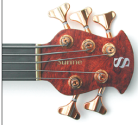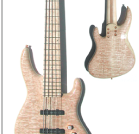Interview with Scott Surine of Surine Basses
By Max Kay
Best Bass Gear
February 17, 2014




Surine Basses is a custom bass manufacturer where each bass is passionately handcrafted to our customers’ orders. You can check out Scott’s current models at www.surinebasses.com. We had an opportunity to interview Scott to get his insight into the bass building business.
How old were you when you built or repaired your first guitar? And was it successful?
At the age of 24-25, I decided to realize my dream of developing a bass concept with interchangeable fingerboards (fretted and fretless). At that time, I had also applied for a utility patent. The process took over a year and a half and cost me every dollar I had made working two jobs to pay for the expense of the prototype and patent attorney fees. Being fabricated from steel as a frame to which the various components were attached, and living in 100+ degree temperatures in Phoenix, I quickly discovered the prototype would heat up in my hands when outdoors. additionally, the steel frame was not structurally sufficient to withstand the tension of the strings. Bottom line, the prototype didn’t work. To make matters worse, another company, Novatone, beat me to the patent, but I learned an incredible amount from the experience. Ten years later, I founded Surine Basses and focused my energies on providing preeminently handcrafted basses for a reasonable price.
Do you have any formal training with your craft, or did you learn by experience?
Not necessarily formal with the luthiery side of the business, but I have a Bachelor’s degree in Graphic Design with which I later worked professionally for 15 years at a major branding firm in Denver. I have been playing bass since I was 13. Both of these skill sets were summoned to fuze my two primary passions into the experience of forming a custom bass manufacturing company. When I started the business in 1992, I had designed a bass for myself and had the experienced luthier, Kenneth Scott Lofquist, build the first Surine bass. Using my design background, I placed an ad in BassPlayer magazine to test the waters for its marketability. The phone started ringing the very first day the ad appeared. I feel my many years as a bass player provides a solid advantage as to what most bass players are looking and listening for in a bass.
Are there any particular woods that you feel work better than others for the instruments you build and/or work on?
Yes, I am a firm believer in Rock Maple for neck woods because of its stability, resonance, and tonal clarity. I also am a big fan of Honduran Mahogany for the body core. The Mahogany adds to the clarity and sustain, but introduces warmth to the overall sound. The customer can choose his/her exotic body caps to further customize the instrument’s voice – i.e. Cocobolo produces a warmer and darker tone than Quilted Maple.
What are favorite specifications for a bass?
My personal preferences are the Maple/Walnut neck core with an Ebony fingerboard. A Mahogany body with either Cocobolo, Quilted Maple, Walnut, Buckeye Burl caps – each sound different, but equally awesome. For a 4-string, 34 scale is fine, but for 5-string and up, the 35 scale provides just that little extra clarity for the low B. I prefer wide string spacing, but is truly up to the customer as far as scale length and string spacing.
Are there are specific brands of hardware (bridges, tuners, etc.) or electronics (Bartolini, EMG, etc.) that you feel work better than others?
Although a range of manufacturer’s brands are available as requested by the customer, my standard offerings are: Gotoh tuners and Bartolini electronics. I also use Hipshot A-style bridges as the standard, but hope to make my own bridge design, the SONOVA bass bridge, the standard moving forward. So far, the SONOVA bass bridge has been installed on twenty+ basses and has been received with resounding approval and enthusiasm.
What was the “biggest” (as in the most work) you ever put into a build or repair job?
The most challenging bass to build thus far has been the “Rainbow Regency” (the primary image seen on the Surine Basses Facebook page) built for a customer in Canada. His initial request to build something like Les Claypool’s Carl Thompson bass took me down a path of wanting to create something truly unique with the lamination of multiple wood species. The result was a 39-piece top with a matching back. The biggest challenge was to get the top and the back wood laminates to line up if viewed from the edge of the bass. The strips of wood are parallel on each wing on the back. They are also parallel on the top over the wings, but because the neck is tapering inward towards the nut, the half-dozen pieces directly over the neck (on the top) had to be slightly tapered so that, once the top was glued as a final unified assembly, it exactly aligned to the laminates on the back. If that wasn’t enough of a challenge, an inlay of a Lion of Judah was also requested. As a graphic designer, I insist that all inlay art is original. A fee was agreed for the inlay design, but the time expenditure for the design effort took about 4x my anticipated design time. The end result was an eye-catching 12th fret inlay with other fret accent inlays that were derived from the 12th fret design. AND IF THAT WASN’T ENOUGH – the customer also wanted the bass to be an 8-string octave bass, with two D-Tuners. This meant adjusting the design of the headstock to accommodate this much hardware while attempting to retain the philosophy of a minimized headstock for balance.
Have there ever been any repair jobs or builds you had to walk away from? And why?
No – This doesn’t mean there hasn’t been extremely challenging moments, but, luckily, all have been successfully resolved.
What bass player you would most like to build for?
There are so many awesome players. I feel blessed to have the opportunity to build for all our appreciative customers. All customers are equally valuable regardless of their degree of professional bass playing success or fame. Discovering the customer’s individual passions and interests helps me to bring relevance to their custom-built bass.
Other than your own work what are some of your other favorite basses?
Well, of course we have to start with Leo Fender and respect his genius and vision. Without Leo Fender, the electric bass may never have come into fruition – or may have been a totally different animal. From there, we have to acknowledge and respect companies such as Alembic – the grandfather of the high-end bass industry, Ken Smith, Michael Pedulla, Michael Tobias, Vinnie Fodera, and so many others I am leaving out. Newer luthiers, such as Kenneth Lawrence, Jens Ritter, and Chris Benavente, bring a new level of excitement to the potential of balancing aesthetics with functionality.
What do you think is the most important thing you’ve learned in your years or building and repairing guitars?
Focus, focus, focus . . . without it, you can easily end up with a pile of wood chips suitable only for your replace – or mulch. Always listen to your customers’ needs, even if it is not your personal preference, and with all of your faculties and to the best of your ability, build the bass of their dreams.
What do you think has been the best advancement in guitar build or repair technology compared to, say, 10 years ago?
New advancements in electronics as for their clarity and diversity in sonic potential provides customers with virtually unlimited options.
What is the #1 tool that you use the most?
My soul. Intangibles such as my hands, eyes, heart, knowledge, experience – all culminate into the final product. And this applies to all luthiers. Other than that, my bandsaw is my bloodline.
What is your favorite grit of sandpaper?
I don’t know about a favorite, but my sequence is 80, to 120, to 220, to 320 grit.
What advice would you give to other builders or techs looking to break into the business?
You have to be willing to put in the time, learn your craft to your best ability, be patient – extremely patient. Learn to work quickly when needed and methodically when needed. never compromise on your vision or settle for less. If you find yourself saying “That’s good enough.” it probably isn’t. I often equate building basses with designing a brand’s logo, or a developing basslines to someone’s original compositions. Here in Colorado, its like hiking a “14er” (14,000 feet+ high mountain peaks). Its unrelenting and you just have to keep at it until you eventually reach the summit. And like a 14er, Instrument building is also unrelenting. It is forever challenging you to bring your “A-game” every day.
Aside from the mental preparation, safety is paramount. Always know where your hands are and develop the ability to predict the nature of certain wood species and the behavior of their grains when machining or working with them by hand.
What do you have on the Horizon for your business / what kind of things can we expect from you in the future?
I am in the process of developing some new models which are, of course, confidential. However, my custom-designed SONOVA bridge will launch in the next issue of BassPlayer magazine and will now be available for other luthiers to use. It is, in my opinion, the most versatile bridge on the market – allowing the user to install it either as a full-assembly or as individual string mounts. Its string spacing is adjustable for 16mm, 17mm, 18mm, or 19mm, or as the individual mounts for anything other than these spacing options.
Lastly, I would like to thank Kenneth Scott Lofquist for being there with me from the beginning and continuing to provide his expertise and fabrication assistance. Roberto Bernardinello should be acknowledged. He has been extremely helpful with his hands-on assistance in developing and maintaining the Surine Basses Facebook page. His enthusiasm and passion for Surine Basses helps keep the motivation dialed to 10 at all times. Lou Laurenti of Bass Southwest also needs acknowledgement. He has brought a level of expertise and provides guidance as pertains to current trends in customer preferences. Of course I cannot forget my wife, Karen, who has been absolutely supportive and encouraging in every aspect and at every crossroad.
Thanks to all Surine Basses customers for your loyalty and appreciation of our products. It has been our honor to serve you. Thank you, Max, for this opportunity to tell the Surine Basses story. Lastly, thank you, readers, for taking the time to read this story.
